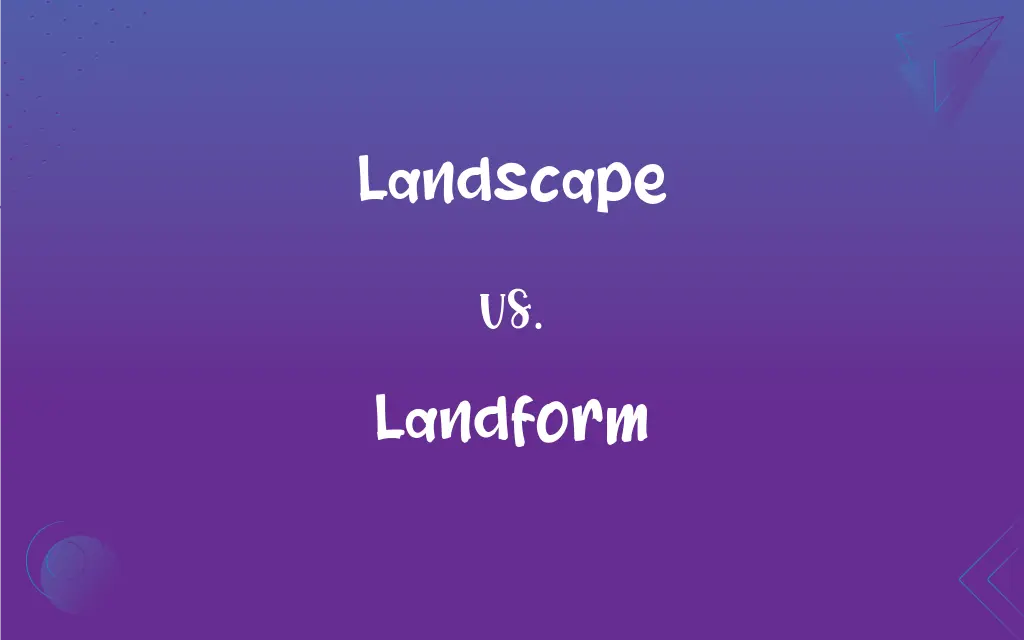Landscape vs. Landform: What's the Difference?
By Aimie Carlson || Updated on May 20, 2024
Landscape refers to the visible features of an area of land, including its physical elements, human influence, and aesthetic aspects, while landform is a specific natural feature on the Earth's surface, such as mountains, valleys, or plains.

Key Differences
A landscape encompasses the overall appearance and composition of a specific area, integrating both natural and human-made elements. It includes mountains, rivers, buildings, roads, and vegetation, forming a cohesive visual scene. A landform, in contrast, is a single natural feature on the Earth's surface, shaped by geological processes such as erosion, weathering, and tectonic activity. Examples of landforms include mountains, hills, plateaus, valleys, and plains.
While landscapes represent the broad, integrated view of an area, incorporating multiple elements and their interactions, landforms focus on individual physical features. Landscapes provide a holistic perspective on an area's natural and cultural environment, whereas landforms offer a detailed examination of specific geological features.
Landscapes can be altered by human activities like agriculture, urban development, and conservation efforts, reflecting cultural and historical contexts. Landforms, however, are primarily shaped by natural forces, although human actions can influence their formation and stability.
In terms of appreciation, landscapes are often valued for their beauty and recreational opportunities, influencing tourism and local economies. Landforms are crucial for scientific study, helping geologists and geographers understand Earth's processes and history.
Comparison Chart
Definition
Visible features of an area, including natural and human elements
Specific natural feature on the Earth's surface
ADVERTISEMENT
Scope
Broad, integrating multiple elements
Narrow, focusing on individual features
Composition
Natural features, human influence, aesthetic aspects
Geological formations shaped by natural processes
Examples
Countryside, urban areas, gardens
Mountains, valleys, plains
Study Field
Geography, ecology, landscape architecture
Geology, physical geography
Human Influence
Significant, can alter appearance
Minimal, primarily natural processes
ADVERTISEMENT
Appreciation
Aesthetic, cultural, ecological
Scientific, geological
Landscape and Landform Definitions
Landscape
A view or scene of an area of land, often appreciated for its beauty.
The artist painted a stunning landscape of the coastal region.
Landform
A physical feature such as a mountain, valley, plateau, or plain.
The scientist studied the unique landforms of the desert region.
Landscape
The overall appearance and composition of a specific area, integrating natural and human-made elements.
The rolling hills and lush vineyards created a picturesque landscape.
Landform
A specific natural feature on the Earth's surface, formed by geological processes.
The Grand Canyon is a famous landform created by erosion.
Landscape
The features of an area that are visible and form a cohesive visual environment.
Urban landscapes include buildings, streets, and parks.
Landform
A distinct shape or form of terrain.
Glaciers have carved out many of the landforms in this area.
Landscape
The integration of ecological, cultural, and aesthetic aspects in a region.
The landscape design focused on creating harmony with the natural surroundings.
Landform
A natural structure resulting from geological activity.
Volcanoes are landforms that result from tectonic movements.
Landscape
An area of land that has been modified by human activity.
The agricultural landscape is dotted with fields and farmhouses.
Landform
A feature that is part of the Earth's topography.
The region is known for its diverse landforms, including hills and rivers.
Landscape
An expanse of scenery that can be seen in a single view
A desert landscape.
Landform
One of the features that make up the earth's surface, such as a plain, mountain, or valley.
Landscape
A picture depicting an expanse of scenery.
Landform
Any geological feature, such as a mountain or valley.
Landscape
The branch of art dealing with the representation of natural scenery.
Landscape
The aspect of the land characteristic of a particular region
A bleak New England winter landscape.
Landscape
Grounds that have been landscaped
Liked the house especially for its landscape.
Landscape
An extensive mental view; an interior prospect
"They occupy the whole landscape of my thought" (James Thurber).
Landscape
The orientation of a page such that the shorter side runs from top to bottom.
Landscape
To adorn or improve (a section of ground) by contouring and by planting flowers, shrubs, or trees.
Landscape
To arrange grounds aesthetically or maintain grounds as a profession.
Landscape
A portion of land or territory which the eye can comprehend in a single view, including all the objects it contains.
Landscape
A sociological aspect of a physical area.
Landscape
A picture representing a real or imaginary scene by land or sea, the main subject being the general aspect of nature, as fields, hills, forests, water, etc.
Landscape
The pictorial aspect of a country.
Landscape
A mode of printing where the horizontal sides are longer than the vertical sides
Landscape
A space, indoor or outdoor and natural or man-made (as in "designed landscape")
Landscape
(figuratively) a situation that is presented, a scenario
The software patent landscape has changed considerably in the last years
Landscape
To create or maintain a landscape.
Landscape
A portion of land or territory which the eye can comprehend in a single view, including all the objects it contains.
Landscape
A picture representing a scene by land or sea, actual or fancied, the chief subject being the general aspect of nature, as fields, hills, forests, water. etc. Compare seascape.
Landscape
The pictorial aspect of a country.
The landscape of his native country had taken hold on his heart.
Landscape
An expanse of scenery that can be seen in a single view
Landscape
Painting depicting an expanse of natural scenery
Landscape
A genre of art dealing with the depiction of natural scenery
Landscape
An extensive mental viewpoint;
The political landscape looks bleak without a change of administration
We changed the landscape for solving the proble of payroll inequity
Landscape
Embellish with plants;
Let's landscape the yard
Landscape
Do landscape gardening;
My sons landscapes for corporations and earns a good living
FAQs
What is a landscape?
A landscape is the visible features of an area, including natural and human-made elements, forming a cohesive visual scene.
Can landscapes change over time?
Yes, landscapes can change due to natural processes and human activities such as development, agriculture, and conservation.
How do landscapes differ from landforms?
Landscapes encompass the overall appearance and composition of an area, integrating multiple elements, while landforms are individual natural features.
Are landforms influenced by human activity?
Landforms are primarily shaped by natural processes, although human actions can affect their formation and stability.
What is a landform?
A landform is a specific natural feature on the Earth's surface, such as a mountain, valley, or plain, shaped by geological processes.
What are examples of landscapes?
Examples include countryside, urban areas, gardens, and coastal regions.
Why are landscapes important?
Landscapes are valued for their aesthetic, cultural, and ecological significance, influencing tourism and local economies.
How do human activities impact landscapes?
Human activities such as agriculture, urban development, and conservation can significantly alter landscapes.
Why are landforms important?
Landforms are crucial for scientific study, helping geologists understand Earth's processes and history.
Can landforms be aesthetically appreciated?
Yes, landforms can be appreciated for their natural beauty and unique shapes.
What is the role of landforms in landscapes?
Landforms are the building blocks of landscapes, contributing to the overall appearance and structure.
How are landforms created?
Landforms are created by geological processes such as erosion, weathering, and tectonic activity.
Can landscapes be designed?
Yes, landscapes can be designed and modified through landscape architecture and planning.
What are examples of landforms?
Examples include mountains, valleys, plateaus, and plains.
Can a landscape include landforms?
Yes, a landscape includes various landforms as part of its overall composition.
What fields study landscapes?
Landscapes are studied in geography, ecology, and landscape architecture.
What fields study landforms?
Landforms are studied in geology and physical geography.
Do landscapes include human-made structures?
Yes, landscapes often include human-made structures like buildings, roads, and parks.
Are all landforms natural?
Yes, landforms are natural features created by Earth's geological processes.
How do landscapes and landforms contribute to ecology?
Landscapes provide diverse habitats for wildlife, while landforms influence climate, water flow, and soil formation.
About Author
Written by
Aimie CarlsonAimie Carlson, holding a master's degree in English literature, is a fervent English language enthusiast. She lends her writing talents to Difference Wiki, a prominent website that specializes in comparisons, offering readers insightful analyses that both captivate and inform.































































